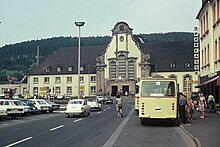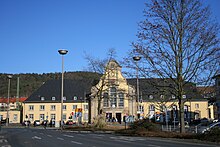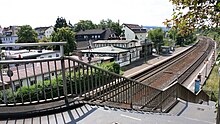Local transport in Marburg

In 1892, through a private initiative, local passenger transport began in Marburg with a regular timetable. Eduard Heppe offered ten trips a day from the train station to the city center in Marburg. The fare was 20 pfennigs. In 1903, the city of Marburg built rails into the streets and ran a privately operated horse-drawn tram . After eight years it was replaced by an electric tram . From 1951 a trolleybus drove . Today the bus is partly operated with modern gas-powered buses. The core of the line network , the connection between the train station located some distance from the old town along the upper town and the southern train station, has already been used by the electric tram. It became the starting point of today's network that also connects the suburbs.
history
Since the Middle Ages, Marburg has been surrounded by a city wall with its houses on the Schlossberg. The establishment of local transport could not play a role. The steep and narrow alleys and streets forbade this. It was only when the Main-Weser Railway opened in 1850 and the Marburg railway station , located far outside the city on the other side of the Lahn , was built that there was a need for local transport. In addition, Marburg prospered after the annexation of the Electorate of Hesse by Prussia in 1866. Above all, the university was supported by Prussia. The city grew out of the medieval walls. The resulting local transport was first taken over by private entrepreneurs with the offer of horse cabs . It is known that the local haulier Schaaf set up a taxi service with a chaise as early as 1878 . Other hauliers followed him. These horse-drawn carriages were waiting for the travelers at the station.
Horse omnibus
This situation changed in 1892. In addition to the individual offer of carriages, the offer of a regular service with a horse-drawn bus was added. This was the beginning of the regular local traffic in Marburg - on a private basis. Eduard Heppe had bought a horse-drawn bus in Bremen in 1892 and drove it to and from the train station ten times a day. The timetable was published in the local press and the tariffs announced in the city's address book. The standard tariff of 20 pfennigs has been in effect for years. Initially, the line ran from the train station via Bahnhofstrasse, Elisabethstrasse, Pilgrimstein and Rudolphsplatz to the "Museum" (later called Stadtsäle) on the corner of Kasernenstrasse (today Gutenbergstrasse) and Universitätsstrasse. After the expansion of Universitätsstraße in 1896, Heppe extended his trips to Wilhelmsplatz.
When Heppe could no longer get his money's worth in 1899, he wanted financial support from the city. The haulier Deckmann approached the city to continue driving the horse-drawn bus without assistance and was encouraged. Deckmann drove his horse-drawn bus from 1899 to 1903 with nine trips a day. Because of financial difficulties, which Deckmann also had to admit a year later, the city approved him to increase the fare to 25 pfennigs. But Deckmann didn't get his money's worth with that either. At his request, in 1902 he was granted a monthly allowance of 80 marks. At that time, however, the introduction of a horse-drawn tram had already been decided by the municipal authorities and the end of horse-drawn buses was foreseeable.
tram
On October 1, a horse-drawn tram was opened between the main train station and Wilhelmsplatz, which was extended to Heumarkt in 1904. In 1911 the electric tram took over. While the branch line to Heumarkt was closed in April 1904 and after a reactivation in 1914, the main line has been extended in several sections to the Südbahnhof. When the streetcar got in the way of the growing car traffic after the Second World War , it was shut down in 1951.
Conversion to trolleybuses in the early 1950s
On May 19, 1951, the age of the trolleybuses began in Marburg . For the most part, they traveled the same route as the tram. Deviating from this, instead of the Pilgrimstein street at the foot of the Schlossberg, a new route was taken via Deutschhausstraße and Biegenstraße to open up the local clinics and residential areas as well as two schools. The tram depot on Gisselberger Strasse was still used for trolleybus operations with minor modifications.
A first series of five one-piece vehicles was procured as initial equipment, and another three vehicles were also supplied by the Uerdingen wagon factory in 1956 . In 1961, articulated trolleybuses were purchased from Henschel in Kassel to cope with the increasing number of passengers . After the trolleybus production at Henschel was discontinued, the municipal utilities purchased two articulated diesel buses that ran together with the trolleybuses on line 1.
After 17 years, on October 5, 1968, the trolleybus operation in Marburg ended. The beginning of the construction of the city motorway , which, due to the topography of Marburg, runs through the middle of the city, would have required significant changes to the infrastructure of the trolleybus.
Operation with diesel buses since the mid-1950s
The omnibuses of the line to the Tannenberg barracks that returned to Marburg after the war were the basis for the line network that was expanded to the neighboring towns in the following years. The southern neighboring town of Cappel has been served by the southern train station following the tram or the trolleybus since 1950. The Sonnenblick sanatorium on the Lahn Mountains was also connected with a line. In 1954, Ockershausen and Marbach were also served by public utility buses. The line to the Landgrafenschloss only operated in the summer months . Wehrda, located north of Marburg, was served by buses from the Rösser company until 1959, when the municipal utilities took over the concession and connected Wehrda on the way via Ortenberg and Waldtal.
After the majority of passengers were initially transported on the trolleybus line, the ratio was reversed in favor of the diesel-powered lines, as the population of the surrounding towns of Ockershausen (city of Marburg), Cappel, Marbach and Wehrda (independent communities) had increased significantly . The diesel bus lines to these suburbs, some of which initially end at the end points of the trolleybus route, became cross-city lines and some of them ran on the same route through the center of Marburg as the trolleybus.
In the 1960s and 1970s, diesel buses were mainly purchased from the manufacturer Magirus-Deutz (types: Saturn II, M150 and standard models ), and from the 1980s onwards from MAN . In between (drove and drive) vehicles from other manufacturers, for example from Büssing and Mercedes-Benz .
Current operation
Bus fleet
Stadtwerke Marburg currently uses articulated buses and solo buses from various companies such as MAN , Mercedes-Benz , Neoplan , Solaris and Van Hool . The articulated buses are mainly used on the heavily used lines, such as lines 1, 2, 4, 6 and 7. The solo buses run on the other lines, such as lines 3, 5 and 8. In the Upper Town, i.e. on lines 10 and 16, midibuses from BredaMenarini and MAN are in use due to the tight conditions.
Natural gas buses from MAN, Mercedes and Neoplan are sometimes used.
The inventory in March 2012 is as follows: low-floor articulated buses with natural gas drive (12 pieces); Low-floor articulated bus (25 pieces); Low-floor bus with natural gas drive (19 pieces); Low-floor bus (12 pieces); Standard bus for special missions (1 bus); Coach (1 piece) midi bus with natural gas drive (4 pieces); Midi bus (1 piece) and minibuses (9 pieces). A total of 84 vehicles are owned by Stadtwerke Marburg GmbH , whereby the old buses are to be continuously replaced by vehicles powered by natural gas.
Due to the increasing number of students and the expansion of the Lahnberge campus outside the city center as well as the construction of the Firmanei campus in the city center, a total of four bus trains will be procured by the Marburg municipal utilities from September 2015 .
railroad
Marburg has two train stations:
- Marburg (Lahn) , the main train station
The station with six platform tracks was opened in 1850, is located in the north of Marburg and is the so-called Hauptbahnhof in Marburg. Regionalbahn, Regionalexpress and InterCity run every day between 15 minutes and every hour. At the weekend this can be up to an hourly rate.
There is also the bus stop at Marburg (Lahn) main station .
The renovation of the station began in 2010. The station building was renovated. Apartments were created on the upper floor. The underpasses and platforms as well as the tracks have also been renewed. A bus station with an electronic departure display has been built on the forecourt .
It is interesting that the Deutsche Bahn never called the station the main station, even for many locals the main station is simply the "station".
- Marburg South
Located in the south of Marburg on Frauenbergstrasse. It has two tracks on two side platforms. The Regional Express and Regionalbahn trains run here every 30 minutes on weekdays and every hour on weekends - every two hours.
In addition, until 1972 there was the Marburg Südbahnhof station of the Marburg district railway about 200 meters south . This was used in passenger and freight traffic. Today it is shut down and the tracks demolished.
Deutsche Bahn announced several times that it is planning another stop at the level of the university library, this stop has already been taken into account in the concept of the Mittelhessen-Express.
The Südbahnhof is connected to the bus network via the Südbahnhof bus stops (city buses and intercity buses) on the east side and the Südbahnhofwest bus stop (city bus route 3 and bus route 383 in the direction of Lohra-Gladenbach-Bad Endbach)
Important bus stops

- Central Station
Most overland lines and many city bus routes to the outer parts of the city depart from the main train station; the bus journey from the main train station to Marburg city center takes around 7 to 10 minutes. The long-distance bus lines also leave near the main train station, but the stop for these is under the bridge of the B3 on the street "Am Krummbogen".
- Rudolphsplatz

With the secondary stops, it is the only stop in Marburg where most bus lines stop. It is the closest stop to get to the old town.
- Gutenbergstrasse / Hanno-Drechsler-Platz
Bus stop in the city center, which locals like to call "Beim Ahrens" after the Ahrens department store located there, and from there you can also quickly get to the upper town
- Südbahnhof
For many commuters from the Rhine-Main area, the change from the train to the city bus lines, as the southern parts of the city can be reached more quickly from here and without a significant detour from the main station (often 20 minutes faster)
Current bus network
Since the timetable change on December 9, 2018, Stadtwerke Marburg GmbH has been operating the following lines in the city:
| line | route |
|---|---|
| 1 | Wehrda - Diakonie - Central Station - City Center - Südbahnhof - Richtsberg |
| 2 | Richtsberg - Sonnenblick - University Hospital - Central Station - City Center - Südbahnhof - Cappel |
| 3 | ( Kaufpark Wehrda ) - Waldtal - Central Station - Südviertel - Südbahnhof West - Cappel |
| 4th | Wehrda - Kaufpark Wehrda - Central Station - City Center - Südbahnhof - Richtsberg |
| 5 | Marbach - main station - city center - Ockershausen - city forest |
| 6th | Main station - Erlenring - Südbahnhof - Badestube - Richtsberg |
| 7th | Main station - city center - Südbahnhof - university hospital |
| F7 | Erlenring - Wilhelmsplatz - Südbahnhof - Hölderlinstraße - University Hospital (bicycle bus ) |
| 8th | Waldtal - Erlenring |
| 9 | Erlenring - University Hospital (express bus) |
| 10 | Main station - Elisabethkirche - castle |
| 11 | Central Station - Ginseldorf - Bauerbach - University Hospital |
| 12 | Südbahnhof - Cappel - Moischt - Schröck - Sonnenblick |
| 13 | Südbahnhof - Ronhausen - Bortshausen - ( Ilschhausen ) (formerly Marburger Kreisbahn ) |
| 14th | Main station - Behringwerke - Görzhäuser Hof - Michelbach - Sterzhausen |
| 15th | Marburg West / Marbach - Radestraße / Richtsberg Comprehensive School (school traffic) |
| 16 | Old University - Sellhof - Wehrshausen - Elnhausen - Dagobertshausen - Dilschhausen |
| 17th | Wilhelmsplatz - Stadtwald - Hermershausen - Haddamshausen - Cyriaxweimar - Stadtwald - Wilhelmsplatz (ring line) |
| 18th | Marburg Ost - Centipede School / Richtsberg Comprehensive School (school traffic) |
| 19th | Wehrda / Cappel - University Hospital |
| 20th | Old University - Rotenberg - Marbach |
| 22nd | Main station - Südbahnhof - Cappel (school traffic) |
The main cycle of the lines has been changed from 20 to 30 minutes. Exceptions are line 7, which has two 30 min. Offers cycles on slightly different routes (runs four times an hour), as well as line 9, which runs every 15 minutes during the lecture period. connects the most important university locations.
City bus routes 6, 8, 9, 10, 17 and 20 are affected due to a full closure of the central Weidenhausen bridge over the Lahn from February 2018, and other routes have been strengthened.
Since December 12, 2010 all evening lines have been canceled. The daily lines continue to run in the evening.
Elevators
Due to its close location in the valley, Marburg is one of the few German cities in which parts of the city are connected by lifts . There are the following public lifts:
- Oberstadtaufzug Rudolphsplatz - runs continuously from the beginning of the Pilgrimstein, near Rudolphsplatz, to Reitgasse (closed shaft, no view, only in operation between 6:30 a.m. and 1:30 a.m.).
- Elevators Parkhaus Oberstadt - a series of two glazed elevators, which are connected by a likewise glazed walkway, connects the rear Pilgrimstein with Wettergasse and at the same time opens up the Oberstadt parking garage
- Elevator in Neuer Ortenbergsteg - connects the main station with Ortenbergplatz
In the past there was also a small elevator of the "Buchhandlung Elwert" between the Pilgrimstein and the main bookstore in the upper town, but this has since been discontinued because the Elwert bookstore was taken over by Lehmann's and the store on Pilgrimstein is now a fashion store.
literature
- Dirk Dannenfeld, Franz-Josef Hanke: With oats, electricity and diesel. 100 years of local transport in Marburg. From the horse-drawn bus to the low-floor articulated bus. [Ed .: Omnibusfreunde Marburg eV] Bonn 1999, ISBN 3-925301-99-2
- Karl-Heinz Gimbel: The Marburg tram, part 1: The horse tram, 1903-1911. Marburg 2011, ISBN 978-3-89703-763-2
Web links
- Association of Local Transport History Marburg e. V.
- Transport company of the Stadtwerke Marburg group of companies
- Current information and pictures about local transport in Marburg ( Memento from January 13, 2011 in the Internet Archive )
- Request for the reintroduction of the tram in the city parliament by Karl-Heinz Gimbel
Individual evidence
- ↑ Template - VO / 0381/2011 Update of the timetables for the university town of Marburg for the timetable change on December 11, 2011 ( Memento of the original from December 8, 2015 in the Internet Archive ) Info: The archive link was inserted automatically and has not yet been checked. Please check the original and archive link according to the instructions and then remove this notice.
- ↑ Press release of the Stadtwerke from March 17, 2015 ( Memento of the original from March 4, 2016 in the Internet Archive ) Info: The archive link was inserted automatically and has not yet been checked. Please check the original and archive link according to the instructions and then remove this notice.
- ↑ Article in the Oberhessische Presse from March 17, 2015
- ↑ Timetable valid from February 26, 2018, accessed on February 26, 2018







